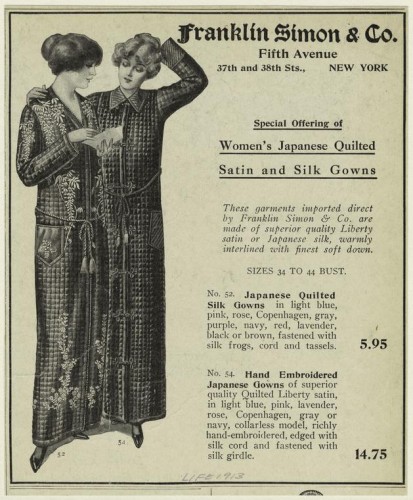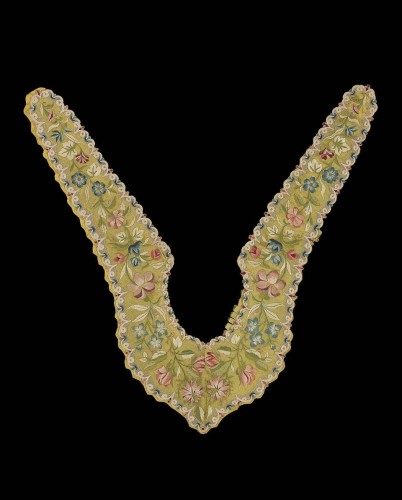For the Historical Sew Fortnightly Challenge #17 we’re going to play with words, and their multiple meanings, a little.
The challenge, due 26 August, is ‘Robes & Robings’, and you can make anything that could be described as a robe, is usually called by the name robe, or has robings. How does this work?

Francesco Sassetti (1421—1490) and His Son Teodoro Domenico Ghirlandaio (Domenico Bigordi) ca. 1488, Metropolitan Museum of Art
The basic T shape that we call a robe, and its many variants, is one of the most classic shapes for garments. As such, it is found across the dress of millenia and continents, ranging from the costumes of some of the peoples mentioned in the bible, to the foundations of medieval garments, through 18th century banyans, Regency evening robes, 19th century wrappers, some tea gowns, and the early 20th century kimono borrowed from the East. If it looks like what we would call a robe today, it counts for this challenge.

Women’s Japanese quilted satin and silk gowns. 1913, NYPL
What else counts? Thing that are called robes by a reasonable percentage of English-language museums and costume books (because if we use French, everything is a robe!), so the 17th and 18th century robe volantes, robe battante, robe à la coer, robe à la française, robe à l’anglaise (+ turques, polonaises, & circassienne), and the 1920s robe de style.
And what are robings? They were also called robins and round robins. Basically they are the trimming round the neck and down the front of 18th and early 19th century gowns and pelisses. The Dictionary of Fashion History (Cummings et al) describe them as:
Broad flat trimmings decorating a gown round the neck and down the front of the bodice, and sometimes continued down the borders of an open over-skirt to the hem
Robings were often made of the same fabric of the gown and permanently attached, but they could also be made of fine lace or other expensive materials in matching sets with stomachers and cuffs, and there are advertisements from the 18th century describing sets of stomacher, cuffs and robings. The LACMA has a pair of engageates and matching shirt robings in dresden and drawn-thread work, and then there is this beautiful robing-collar from the MFA Boston:
The most obvious use of robings is on 18th century robes, but the name continued to be used for trimmings well into the 19th century. A 1829 Lady’s Magazine describes”a chemisette of fine lawn, where the robings open en reverse…” , and an 1830s Lady’s Magazine describes a pelisse of green watered silk with “lapel robings, on the chest robings, en tablier, on the skirt, fastened down the front with small knots…the whole of the robings edged with dents”, and the 1840 Workwoman’s Guide gives instructions on dressing skirts with robings that match the bodice. While the Workwoman’s Guide could be a bit old-fashioned, other contemporary fashion magazines show that robings and fichu-robings could still be very much the vogue.

Redingote with robings on the bodice and skirt, 1822-23, Centraal Museum
And what are fichu robings? Based on contemporary descriptions of the 1820s-40s, they are robing-style trimmings that cover the shoulders of the bodice, and extend down into the bodice point. The 1829 Lady’s Magazine describes “a dress made plain with fichu-robings, cleft at the shoulder and descending en guimpe to the sash where they meet in a point and are trimmed in a ruche of blond [lace]”

Dress with fichu robings, 1840s, The Centre de Documentació i Museu Tèxtil de Terrassa
How’s that! A challenge and a terminology post! I’m on fire! Now wait until you see all the sewing I have gotten done!




Would a half-robe count? 😀
I’m still not sure I understand what robings are…
Wow. My Byzantine himation may count! If I can just get it started, I might be able to enter it and finish it in time for this challenge. (….Lost in thought…)
Ok–What is the difference between an anglaise, a polonaise, and a francaise? Ok, besides the beginning of an ethnic joke, and ethnic jokes are gross so we won’t go there. Really–I would love to know the fashion differences!
Also, having been disinclined to like the Rate The Dress for this week, I would like to shift and rate the bottom dress: 10
I would never have thought that could become a bad ethnic joke…
Very basically, a francaise is a sack gown with flowing back pleats, an anglaise has a fitted back, and a polonaise has picked-up and bustled skirts (there is considerable debate in the historical costuming community as to whether a polonaise is a type of gown in its own right, or just an anglaise with picked-up skirts).
Dreamstress–thank you for the terminology help! Also, you’re welcome for the bad joke start. 😉
Thank you, Elise! I can just hear how it would go. ‘An anglaise, a polonaise, and a francaise were hanging about in a wardrobe…’
🙂
Hahaha!
http://isabelladangelo.blogspot.com/2013/08/historical-fortnightly-17-robes-robings.html
I made a giornea – 1490’s Florentine fancy/ceremonial overgown- for the robe challenge. The gamurra – dress- will be for the next challenge.
http://cursewordsandcrinolines.blogspot.com/2013/08/hsf-challenge-17-robes-and-robings.html
Back on the HSF wagon after having fallen off for the last 6 weeks or so 🙂 here is my Robe Battante from this spring.
Phew! I finished something for the HSF! Hooray!
http://kittycalash.com/2013/08/28/hsf17-robes-robings/
I’ve loved the print for years, so this was a good spur to get something challenging made.